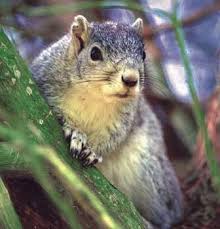This week’s endangered species is the Delmarva Fox Squirrel (Sciurus niger cinereus)(photo from newsforsquirrels.blogspot.com). For those folks not in the Chesapeake Bay watershed, “Delmarva” is the peninsula that runs along the eastern shore of the Chesapeake Bay; the Delmarva fox squirrel was historically found all along the Delmarva peninsula. According to the species recovery plan, it’s now down to just 10% of its historical population (it was listed as federally endangered in 1967). It is currently found in eight counties on the Eastern Shore of Maryland (all but Cecil) and Sussex County, Delaware and Accomack County, Virginia (from U.S. FWS Species Profile). What’s causing the decline of this species? I know I’m sounding like a broken record in these endangered species posts, but once again, the main culprit seems to be habitat fragmentation and loss.
historically found all along the Delmarva peninsula. According to the species recovery plan, it’s now down to just 10% of its historical population (it was listed as federally endangered in 1967). It is currently found in eight counties on the Eastern Shore of Maryland (all but Cecil) and Sussex County, Delaware and Accomack County, Virginia (from U.S. FWS Species Profile). What’s causing the decline of this species? I know I’m sounding like a broken record in these endangered species posts, but once again, the main culprit seems to be habitat fragmentation and loss.
 According to the Chesapeake Bay Field Office of the U.S. Fish and Wildlife Service, the fox squirrel likes to live in old growth hardwood and pine forests, eating nuts or mature green pine cones. During the spring, these squirrels add a little variety to their diets in the form of buds, flowers, fungi, seeds, and even insects. Delmarva fox squirrels prefer to live in dens in hollowed-out trees, but will build nests in the branches of trees, much like the more familiar gray squirrel (Sciurus carolinensis). Delmarva fox squirrels breed in the late winter and early spring; after a 44 day gestation, they give birth to a litter of up to 6 squirrels between February and April.
According to the Chesapeake Bay Field Office of the U.S. Fish and Wildlife Service, the fox squirrel likes to live in old growth hardwood and pine forests, eating nuts or mature green pine cones. During the spring, these squirrels add a little variety to their diets in the form of buds, flowers, fungi, seeds, and even insects. Delmarva fox squirrels prefer to live in dens in hollowed-out trees, but will build nests in the branches of trees, much like the more familiar gray squirrel (Sciurus carolinensis). Delmarva fox squirrels breed in the late winter and early spring; after a 44 day gestation, they give birth to a litter of up to 6 squirrels between February and April.
Here are 5 reasons to save the Delmarva Fox Squirrel:
1) By preserving the forests on which these squirrels depend, we’re also helping many other, less charismatic but equally important, species
2) The Delmarva fox squirrel population seems to be responding positively to reintroduction attempts (see MD DNR update) – there’s hope!
3) Species such as the Delmarva fox squirrel, that move and eat seeds and nuts, help to maintain forest ecosystem health and reproduction
4) Research indicates that these squirrels can survive in a landscape managed for agriculture and sustainable timber harvest
5) Oh my gosh, how cute are these little guys?
 If you’re headed to New England this summer and you’d like to learn a little something about sustainable fisheries and whales, a visit to the New Bedford Whaling Museum is definitely in order! I know, when you're thinking green getaways, whaling doesn't often come to mind, but this museum is very informative and really tells a very honest story of the history and impacts of whaling. The museum, which is over 100 years old, sits next to the New Bedford
If you’re headed to New England this summer and you’d like to learn a little something about sustainable fisheries and whales, a visit to the New Bedford Whaling Museum is definitely in order! I know, when you're thinking green getaways, whaling doesn't often come to mind, but this museum is very informative and really tells a very honest story of the history and impacts of whaling. The museum, which is over 100 years old, sits next to the New Bedford Whaling National Historic Park. It’s filled with many exhibits on the local area and the history of whaling in the area. The museum also includes fascinating displays giving information on various whale species (I especially like the comparison between a t-rex tooth and a whale tooth) and the impacts of overfishing and depletion of natural resources. The museum has the world’s largest library of whaling logbooks, the world’s largest collection of scrimshaw (unbelievably detailed work!), and the world’s largest model ship, the Lagoda, a half-scale whale ship built in 1916. Many of the exhibits are hands-on, which always makes a museum visit more fun. A fascinating and honest look at the whaling industry, the New Bedford Whaling Museum is worth a visit!
Whaling National Historic Park. It’s filled with many exhibits on the local area and the history of whaling in the area. The museum also includes fascinating displays giving information on various whale species (I especially like the comparison between a t-rex tooth and a whale tooth) and the impacts of overfishing and depletion of natural resources. The museum has the world’s largest library of whaling logbooks, the world’s largest collection of scrimshaw (unbelievably detailed work!), and the world’s largest model ship, the Lagoda, a half-scale whale ship built in 1916. Many of the exhibits are hands-on, which always makes a museum visit more fun. A fascinating and honest look at the whaling industry, the New Bedford Whaling Museum is worth a visit!








 about this hunting style is the fact that these spiders don’t have eyes (from
about this hunting style is the fact that these spiders don’t have eyes (from 



 According to the
According to the 

 lending your voice to this important cause. Here’s some information about the rally and the underlying issue – you’ll want to do a little homework before deciding whether or not to participate.
lending your voice to this important cause. Here’s some information about the rally and the underlying issue – you’ll want to do a little homework before deciding whether or not to participate. North America, usually 1 to 1.5 inches. Talk about a unique lifestyle! Here’s how the
North America, usually 1 to 1.5 inches. Talk about a unique lifestyle! Here’s how the 
 Movement, and, in 2004, became the first African woman to receive the Nobel Peace Prize. This memoir recounts her early childhood in Kenya during colonial times, her studies in the U.S., and her return to Kenya. We learn how Maathai started and developed the Green Belt Movement, which was a network of rural women who grew and planted trees throughout Kenya (over 40 million trees according to the book). The reader also follows her journey through the political landscape of Kenya as democracy developed. Written in a very matter-of-fact tone, this memoir is not exactly an edge-of-your-seat thriller, but the reader’s patience pays off. As Maathai calmly describes the many ups and downs of her personal journey, the reader gets a detailed look at the sacrifices this remarkable woman made for the country and environment she loved.
Movement, and, in 2004, became the first African woman to receive the Nobel Peace Prize. This memoir recounts her early childhood in Kenya during colonial times, her studies in the U.S., and her return to Kenya. We learn how Maathai started and developed the Green Belt Movement, which was a network of rural women who grew and planted trees throughout Kenya (over 40 million trees according to the book). The reader also follows her journey through the political landscape of Kenya as democracy developed. Written in a very matter-of-fact tone, this memoir is not exactly an edge-of-your-seat thriller, but the reader’s patience pays off. As Maathai calmly describes the many ups and downs of her personal journey, the reader gets a detailed look at the sacrifices this remarkable woman made for the country and environment she loved.